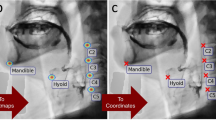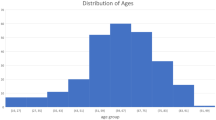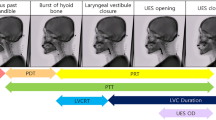Abstract
The hyoid bone displacement and rotation are critical kinematic events of the swallowing process in the assessment of videofluoroscopic swallow studies (VFSS). However, the quantitative analysis of such events requires frame-by-frame manual annotation, which is labor-intensive and time-consuming. Our work aims to develop a method of automatically tracking hyoid bone displacement and rotation in VFSS. We proposed a full high-resolution network, a deep learning architecture, to detect the anterior and posterior of the hyoid bone to identify its location and rotation. Meanwhile, the anterior-inferior corners of the C2 and C4 vertebrae were detected simultaneously to automatically establish a new coordinate system and eliminate the effect of posture change. The proposed model was developed by 59,468 VFSS frames collected from 1488 swallowing samples, and it achieved an average landmark localization error of 2.38 pixels (around 0.5% of the image with 448 × 448 pixels) and an average angle prediction error of 0.065 radians in predicting C2–C4 and hyoid bone angles. In addition, the displacement of the hyoid bone center was automatically tracked on a frame-by-frame analysis, achieving an average mean absolute error of 2.22 pixels and 2.78 pixels in the x-axis and y-axis, respectively. The results of this study support the effectiveness and accuracy of the proposed method in detecting hyoid bone displacement and rotation. Our study provided an automatic method of analyzing hyoid bone kinematics during VFSS, which could contribute to early diagnosis and effective disease management.




Similar content being viewed by others
Data Availability
Data generated or used for the study are available from the corresponding author by request.
References
M. Aslam and M. F. Vaezi, ‘Dysphagia in the elderly’, Gastroenterol. Hepatol. (N. Y.), vol. 9, no. 12, pp. 784–795, Dec. 2013.
M. Crary, L. Sura, A. Madhavan, and G. Carnaby-Mann, “Dysphagia in the elderly: management and nutritional considerations,” Clinical Interventions in Aging, p. 287, 7 2012.
A. M. Namasivayam and C. M. Steele, “Malnutrition and dysphagia in long-term care: A systematic review,” Journal of Nutrition in Gerontology and Geriatrics, vol. 34, pp. 1–21, 1 2015.
C. M. Sarabia-Cobo et al., ‘The incidence and prognostic implications of dysphagia in elderly patients institutionalized: A multicenter study in Spain’, Appl. Nurs. Res., vol. 30, pp. e6-9, May 2016.
M. Streicher, R. Wirth, K. Schindler, C. C. Sieber, M. Hiesmayr, and D. Volkert, “Dysphagia in nursing homes—results from the nutritionday project,” Journal of the American Medical Directors Association, vol. 19, pp. 141–147.e2, 2 2018.
P. E. Spronk, L. E. J. Spronk, J. Lut, E. Gnacke, D. Mijnes, B. van Munster, and A. Kroner, “Prevalence and characterization of dysphagia in hospitalized¨ patients,” Neurogastroenterology & Motility, vol. 32, 3 2020.
M. González-Fernández, L. Ottenstein, L. Atanelov, and A. B. Christian, ‘Dysphagia after stroke: An overview’, Curr. Phys. Med. Rehabil. Rep., vol. 1, no. 3, pp. 187–196, Sep. 2013.
R. Martino, N. Foley, S. Bhogal, N. Diamant, M. Speechley, and R. Teasell, “Dysphagia after stroke,” Stroke, vol. 36, pp. 2756–2763, 12 2005.
J. Logemann, “Evaluation and treatment of swallowing disorders,” NSSLHA Journal, vol. 12, pp. 38–50, 11 1984.
R. Martino, G. Pron, and N. Diamant, “Oropharyngeal dysphagia: Surveying practice patterns of the speech?language pathologist,” Dysphagia, vol. 19, 8 2004.
B. Martin-Harris and B. Jones, “The videofluorographic swallowing study,” Physical Medicine and Rehabilitation Clinics of North America, vol. 19, pp. 769–785, 11 2008.
G. Dengel, J. Robbins, and J. C. Rosenbek, “Image processing in swallowing and speech research,” Dysphagia, vol. 6, pp. 30–39, 3 1991.
J. Logemann, P. Kahrilas, J. Begelman, W. Dodds, and B. Pauloski, “Interactive computer program for biomechanical analysis of videoradiographic studies of swallowing,” American Journal of Roentgenology, vol. 153, pp. 277–280, 8 1989.
W. J. Dodds, J. A. Logemann, and E. T. Stewart, “Radiologic assessment of abnormal oral and pharyngeal phases of swallowing.,” American Journal of Roentgenology, vol. 154, pp. 965–974, 5 1990.
J. G. J. van der Kruis, L. W. J. Baijens, R. Speyer, and I. Zwijnenberg, “Biomechanical analysis of hyoid bone displacement in videofluoroscopy: A systematic review of intervention effects,” Dysphagia, vol. 26, pp. 171–182, 6 2011.
H. Opdebeeck, W. H. Bell, J. Eisenfeld, and D. Mishelevich, “Comparative study between the SFS and LFS rotation as a possible morphogenic mechanism,” Am. J. Orthod., vol. 74, pp. 509–521, Nov. 1978.
N. Jose, S. Shetty, S. Mogra, V. Shetty, S. Rangarajan, and L. Mary, “Evaluation of hyoid bone position and its correlation with pharyngeal airway space in different types of skeletal malocclusion,” Contemporary Clinical Dentistry, vol. 5, p. 187, 2014.
I. P. Adamidis and M. N. Spyropoulos, “The effects of lymphadenoid hypertrophy on the position of the tongue, the mandible and the hyoid bone,” Eur. J. Orthod., vol. 5, pp. 287–294, Nov. 1983.
A. L. Perlman, D. J. VanDaele, and M. S. Otterbacher, “Quantitative assessment of hyoid bone displacement from video images during swallowing,” Journal of Speech, Language, and Hearing Research, vol. 38, pp. 579–585, 6 1995.
G. H. McCullough, R. T. Wertz, J. C. Rosenbek, R. H. Mills, W. G. Webb, and K. B. Ross, “Inter- and intrajudge reliability for videofluoroscopic swallowing evaluation measures,” Dysphagia, vol. 16, pp. 110–118, 3 2001.
M. A. Crary, G. D. C. (Mann), and M. E. Groher, “Biomechanical correlates of surface electromyography signals obtained during swallowing by healthy adults,” Journal of Speech, Language, and Hearing Research, vol. 49, pp. 186–193, 2 2006.
P. M. Kellen, D. L. Becker, J. M. Reinhardt, and D. J. V. Daele, “Computer-assisted assessment of hyoid bone motion from videofluoroscopic swallow studies,” Dysphagia, vol. 25, pp. 298–306, 12 2010.
I. Hossain, A. Roberts-South, M. Jog, and M. R. El-Sakka, “Semi-automatic assessment of hyoid bone motion in digital videofluoroscopic images,” Computer Methods in Biomechanics and Biomedical Engineering: Imaging & Visualization, vol. 2, pp. 25–37, 1 2014.
S. Mao, Z. Zhang, Y. Khalifa, C. Donohue, J. L. Coyle, and E. Sejdic, “Neck sensor-supported hyoid bone movement tracking during swallowing,” Royal Society Open Science, vol. 6, p. 181982, 7 2019.
A. Voulodimos, N. Doulamis, A. Doulamis, and E. Protopapadakis, “Deep learning for computer vision: A brief review,” Computational Intelligence and Neuroscience, vol. 2018, pp. 1–13, 2018.
D. Shen, G. Wu, and H.-I. Suk, “Deep learning in medical image analysis.,” Annual review of biomedical engineering, vol. 19, pp. 221–248, 2017.
Z. Zhang, S. Mao, J. Coyle, and E. Sejdić, ‘Automatic annotation of cervical vertebrae in videofluoroscopy images via deep learning’, Med. Image Anal., vol. 74, no. 102218, p. 102218, Dec. 2021.
Z. Zhang, J. L. Coyle, and E. Sejdić, ‘Automatic hyoid bone detection in fluoroscopic images using deep learning’, Sci. Rep., vol. 8, no. 1, p. 12310, Aug. 2018.
D. Lee, W. H. Lee, H. G. Seo, B.-M. Oh, J. C. Lee, and H. C. Kim, “Online learning for the hyoid bone tracking during swallowing with neck movement adjustment using semantic segmentation,” IEEE Access, vol. 8, pp. 157451–157461, 2020.
H.-I. Kim, Y. Kim, B. Kim, D. Y. Shin, S. J. Lee, and S.-I. Choi, “Hyoid bone tracking in a videofluoroscopic swallowing study using a deep-learning-based segmentation network,” Diagnostics, vol. 11, p. 1147, 6 2021.
M.-Y. Hsiao, C.-H. Weng, Y.-C. Wang, S.-H. Cheng, K.-C. Wei, P.-Y. Tung, J.-Y. Chen, C.-Y. Yeh, and T.-G. Wang, “Deep learning for automatic hyoid tracking in videofluoroscopic swallow studies,” Dysphagia, 4 2022.
S. M. Molfenter and C. M. Steele, “Kinematic and temporal factors associated with penetration–aspiration in swallowing liquids,” Dysphagia, vol. 29, pp. 269–276, 4 2014.
Y. Matsuda, E. Ito, Y. Kimura, and K. Araki, “Hyoid bone position related to gender and aging using lateral cephalometric radiographs,” Orthod. Waves, vol. 77, pp. 226–231, Dec. 2018.
K. Sun, Y. Zhao, B. Jiang, T. Cheng, B. Xiao, D. Liu, Y. Mu, X. Wang, W. Liu, and J. Wang, “High-resolution representations for labeling pixels and regions,” 4 2019.
K. Sun, B. Xiao, D. Liu, and J. Wang, “Deep high-resolution representation learning for human pose estimation,” 2 2019.
J. Wang, K. Sun, T. Cheng, B. Jiang, C. Deng, Y. Zhao, D. Liu, Y. Mu, M. Tan, X. Wang, W. Liu, and B. Xiao, “Deep high-resolution representation learning for visual recognition,” 8 2019.
D. P. Kingma and J. Ba, “Adam: A method for stochastic optimization,” 12 2014.
K. Weiss, T. M. Khoshgoftaar, and D. Wang, “A survey of transfer learning,” Journal of Big Data, vol. 3, p. 9, 12 2016.
J. Deng, W. Dong, R. Socher, L.-J. Li, K. Li, and L. Fei-Fei, “Imagenet: A large-scale hierarchical image database,” pp. 248–255, IEEE, 6 2009.
K. He, X. Zhang, S. Ren, and J. Sun, “Deep residual learning for image recognition,” 12 2015.
Y. Chen, Z. Wang, Y. Peng, Z. Zhang, G. Yu, and J. Sun, “Cascaded pyramid network for multi-person pose estimation,” 11 2017.
B. Xiao, H. Wu, and Y. Wei, “Simple baselines for human pose estimation and tracking”, arXiv [cs.CV], 17-Apr-2018.
A. Ross and V. L. Willson, ‘Independent Samples T-Test’, in Basic and Advanced Statistical Tests, Rotterdam: SensePublishers, 2017, pp. 13–16.
A. Ross and V. L. Willson, “Paired Samples T-Test”, in Basic and Advanced Statistical Tests, Rotterdam: SensePublishers, 2017, pp. 17–19.
B. Cheng, B. Xiao, J. Wang, H. Shi, T. S. Huang, and L. Zhang, “Higherhrnet: Scale-aware representation learning for bottom-up human pose estimation,” 8 2019.
Funding
This work was supported by the Eunice Kennedy Shriver National Institute of Child Health & Human Development of the National Institute of Health under Award Number R01HD092239, while the data were collected under Award Number R01HD074819. The content is solely the responsibility of the authors and does not necessarily represent the official views of the National Institute of Health.
Author information
Authors and Affiliations
Corresponding author
Ethics declarations
Ethics Approval
The Institutional Review Board at the University of Pittsburgh approved the protocol of this study, and all participants provided informed consent.
Competing Interests
The authors declare no competing interests.
Additional information
Publisher's Note
Springer Nature remains neutral with regard to jurisdictional claims in published maps and institutional affiliations.
Rights and permissions
Springer Nature or its licensor (e.g. a society or other partner) holds exclusive rights to this article under a publishing agreement with the author(s) or other rightsholder(s); author self-archiving of the accepted manuscript version of this article is solely governed by the terms of such publishing agreement and applicable law.
About this article
Cite this article
Li, W., Mao, S., Mahoney, A.S. et al. Automatic Tracking of Hyoid Bone Displacement and Rotation Relative to Cervical Vertebrae in Videofluoroscopic Swallow Studies Using Deep Learning. J Digit Imaging. Inform. med. (2024). https://doi.org/10.1007/s10278-024-01039-4
Received:
Revised:
Accepted:
Published:
DOI: https://doi.org/10.1007/s10278-024-01039-4




